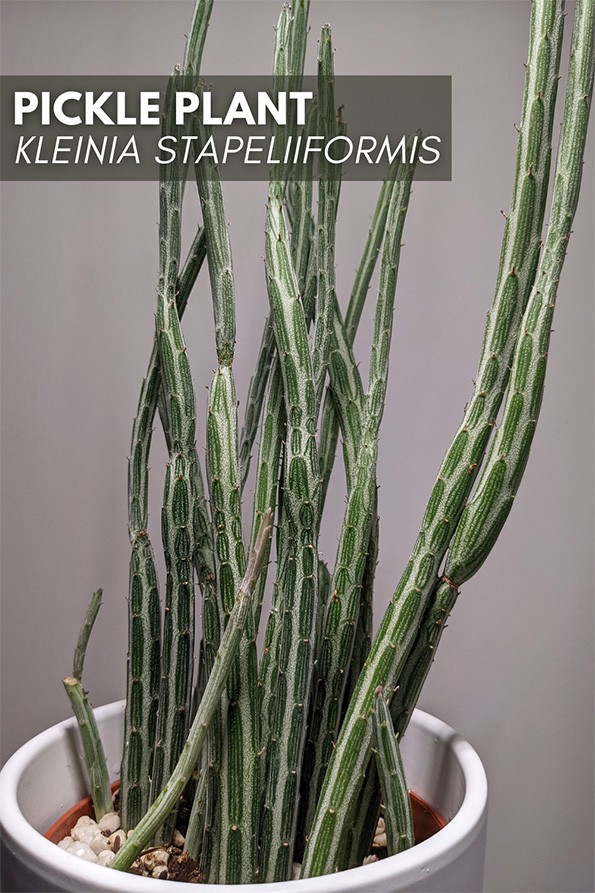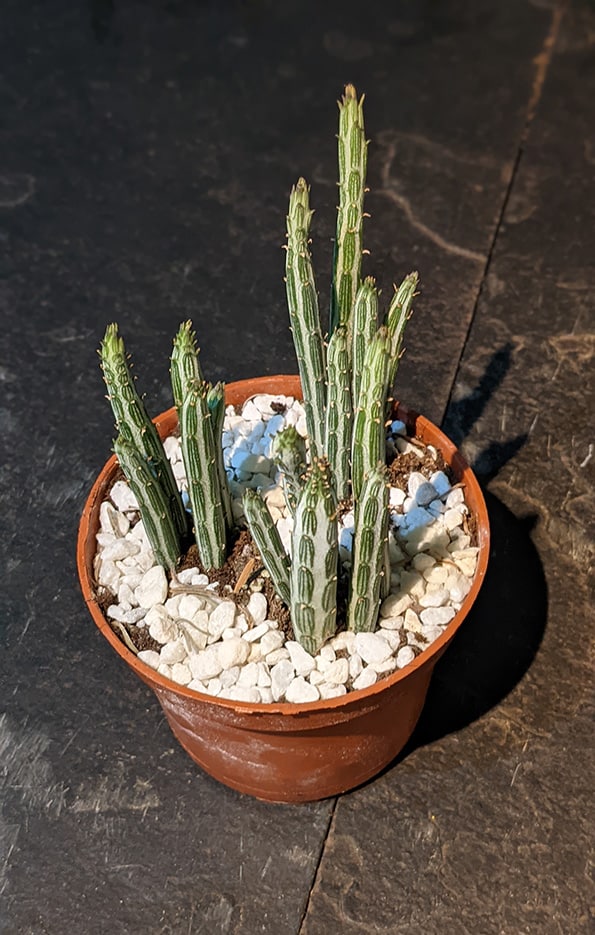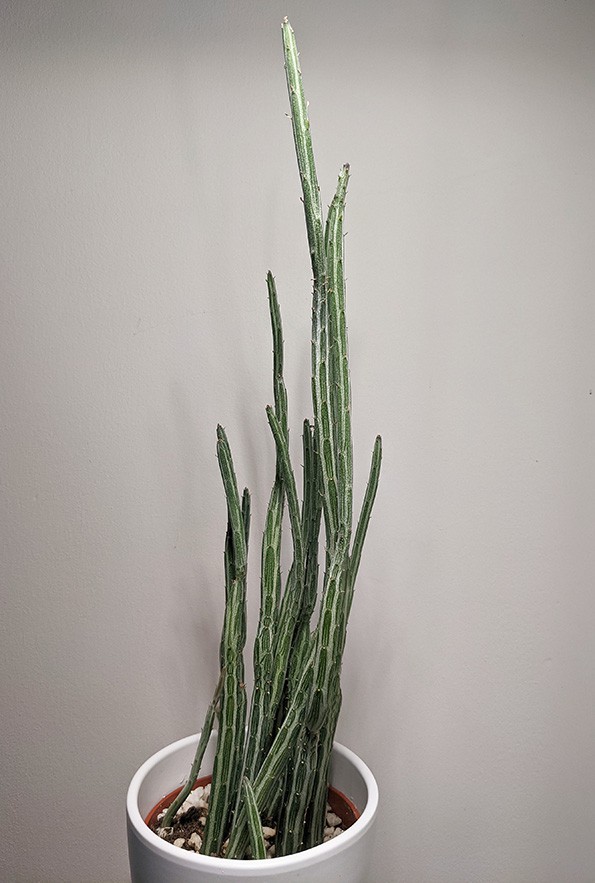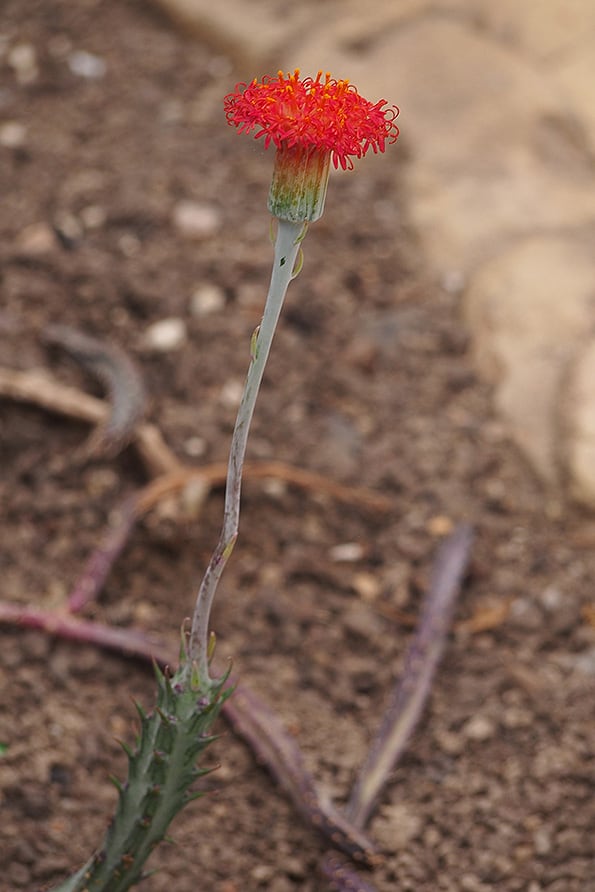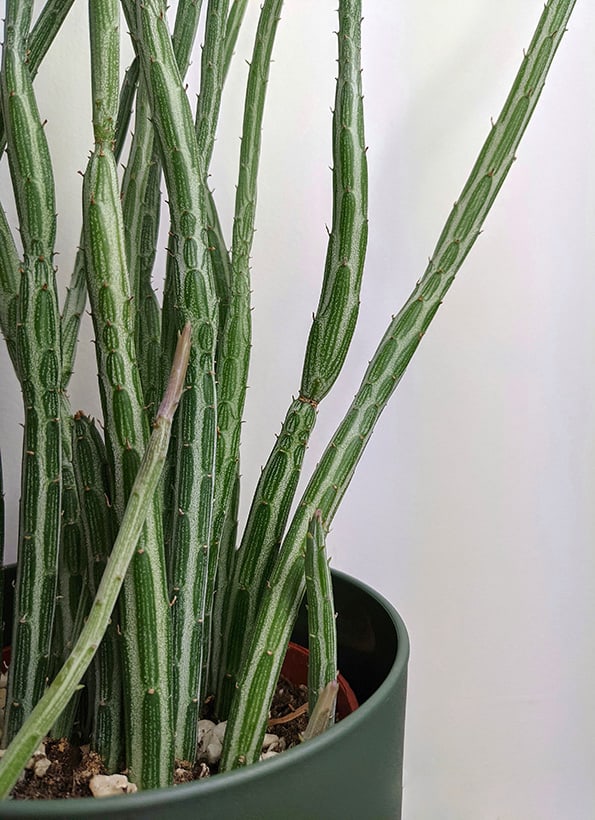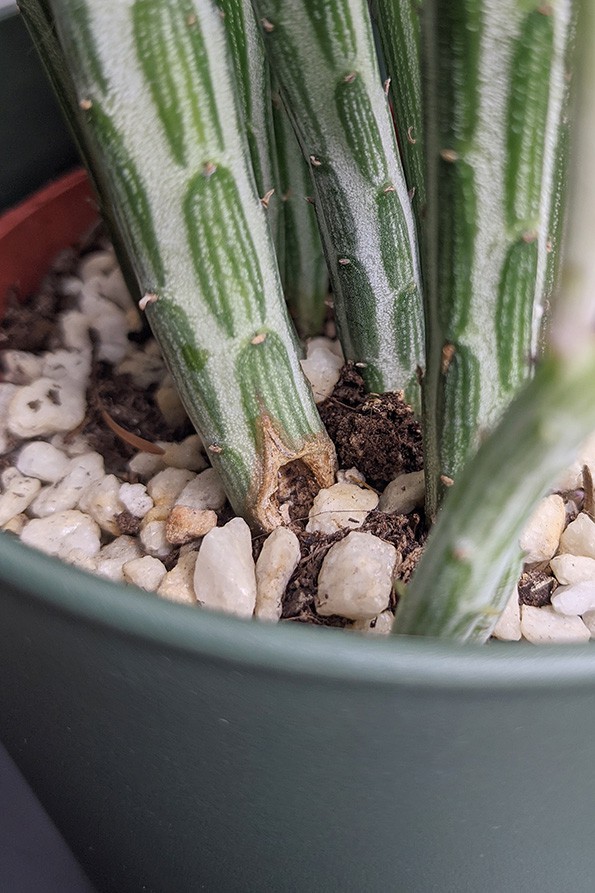Kleinia stapeliiformis, also known as Senecio stapeliiformis, is an excellent architectural houseplant with a fairly small footprint. Give it full sun and a little support and you'll have tall reaching stems in no time.
Arguably the best part are the patterns on the stems. They're typically green, cylindrical, and covered with small tubercles or bumps, giving them their distinctive pickle-like appearance, looking like little cucumbers or pickles. Hence its common name of "Pickle Plant".
What do you see first? The elegant pencil like stems? Little Pickles or a Cucumber pattern on the stems. All descriptions people have used to describe this unusual houseplant.
Kleinia stapeliiformis is another one of those houseplants with a complicated past. It's gone by several names over the years and the common name "Pickle Plant" sometimes gets confused with other houseplants.
Don't get confused.
There is another "Pickle Plant" called Delosperma echinatum. Another plant called Euphorbia tirucalli, sometimes goes by the name "Pencil Plant". If you're buying or talking about the "Pickle Plant" make sure it's definitely the Kleinia stapeliiformis.
One of the old names is Senecio stapeliiformis. The Pickle Plant does have a Senecio look about them for sure (thin, slightly chalky stems that can barely hold themselves upright). They're a bit like another "Senecio" love of mine, the Curio Ficoides "Mount Everest".
So although you may see different names on plant labels, Kleinia stapeliiformis is the current and accepted scientific name.
They're a reasonably new houseplant and don't have a huge presence in the world, only native to South Africa. They're different from many other indoor plants and worth growing if you like their look and growth habits.
How do you pronounce Kleinia stapeliiformis correctly? Say:
KLY-nee-uh Stuh-PEE-lee-ih-FOR-mis
This plant reminds me of so many different things. Pencils and Pickles of course, but also like the sea tendrils or tentacles from a Disney movie, reaching and tangling. They also look a little alien and not quite real. Unique and strange and beautiful in equal measures.
They're not expensive either. So one particular cold Spring whilst holidaying in Totnes England a few years back I was feeling adventurous and decided to give it a go. You can see it on the shop owner's counter while I was waiting to pay below.
Here is my very own Pickle Plant on the first day we met a few years ago. Every other photo in the article is the same plant from then up until today.
If you've followed me for a while, you'll know I don't write about plants that I don't actually own. And I never write about plants I've only had for a short time.
My Kleinia stapeliiformis has been with me for several years now and, so I can tell you with confidence that they're super easy to care for. If you get the light and watering right, the rest will follow. I'm going to talk you through everything next.

Hi, I'm Tom!
If you're like me and enjoy the challenge of growing houseplants and getting them to thrive, then Ourhouseplants can help. This website shares my knowledge and years of growing plants and provides (hopefully) helpful advice on properly caring for your indoor plant friends.
Provide as much light as possible by putting them in your home's sunniest spot. That would be their first choice (FYI - the stems may take on a purple hue in these spots)
The Pickle Plant's second pick is a bright location in an East or west-facing window with a few hours of sun a day. In third place will be a bright location.
They love the sun, so anything darker than at least a little sun will slow growth and potentially change the aesthetics of how the plant grows.
During late spring and over the summer months, if the light levels are high, this will be a reasonably thirsty houseplant for its size.
The rule of thumb is to wait until the potting mix has completely dried out before you water it again.
Over winter or in lower light levels, the water need will reduce considerably and you'll need to cut back to prevent overwatering and root rot.
I only water mine occasionally over winter and only just enough to keep it ticking over. They stop growing and go dormant when it's cooler, so they'll only use a fraction of the water they drank over the summer.
Overall the Pickle Plant isn't fazed by the different humidity levels found in the average home setting. They can be grown anywhere (as long as there is good light).
If you plan to make their unusual look into a display feature, they can theoretically cope with a bottle garden or terrarium. However these places will typically have unnaturally high humidity levels and poor ventilation.
So I'd only recommend these display cabinets if you really know what you're doing and if you're super careful because rot is the most common issue with these plants.
Comparatively, Kleinia stapeliiformis is quite a small plant. It simply doesn't need significant quantities of feed over the year. Once every three months, using a standard houseplant feed or succulent fertilizer should be plenty.
The Pickle Plant features thick, erect stems that grow either upright or slightly trailing, reaching heights of up to 12 inches (30 cm). Compared to some houseplants this is fairly small, and it doesn't need large amounts of feed.
Kleinia stapeliiformis needs warm temperatures to do well indoors and prevent dormancy from triggering. Providing the daytime temperature ranges somewhere between 18°C (65°F) and 27°C (80°F) you should be fine.
When temperatures dip below this range, growth will probably stop and only resume in Spring when things warm up again.
During this dormancy period it should be able to cope with temperatures as low as 5°C (41°F) provided the potting mix is dry. Avoid frost and freezing temperatures.
They rarely need repotting. The roots are not particularly vigorous or large and will be pretty happy in a semi-cramped location for several years. Aim to repot when you notice the potting mix is breaking down, or when things are obviously uncomfortably restricted.
When you buy these plants, they'll often come in a generic potting mix, usually made of 100% peat or coconut coir. If you're careful, you could leave them in this potting mix. However, switching them into well-draining soil with a gritty texture could be the better approach for extra safety.
What I did was upot mine. I noticed the roots were nowhere near filling the pot (so there was no need to change things up). I simply knocked off some of the existing potting mix and combined it with a more gritty mix I had. Then, I repotted my Pickle Plant into the same container using this DIY blend.
Watch me talk about my Pickle plant over on YouTube.
There are two main ways to create new Pickle Plants. They are separating and growing on offsets or stem cuttings.
Offsets: The plant may produce offsets or "pups" around the base of the plant. Carefully remove these offsets and plant them in their own pots with well-draining soil. Water lightly and provide bright, indirect light.
Two Top Tip
1. Only attempt to propagate in Summer. The plant is usually highly active at this point and propagation should work better and quicker.
2. These plants look good in clusters rather than single stems. Put several offsets or cuttings in the same pot for best results.
Stem Cuttings: Take stem cuttings from healthy, mature stems of the Pickle Plant using clean, sharp shears. No more than an inch or two. Allow the cuttings to callus over for a few days to prevent rotting.
Plant the cuttings in a well-draining succulent or cactus mix and keep the soil lightly moist. Roots should develop within a few weeks to a couple of months.
If you're growing them in some full sun and the temperature is warm, growth can be fairly quick. A small plant can easily double or triple in size within a year. It's normal for no growth to occur from the start of Fall until Spring the following year.
The stems will eventually reach a maximum length of 30cm / 12inches. They can sometimes branch and therefore appear longer than this, but this is less common in young plants.
If you provide good light levels and a small amount of support, such as leaning against a wall or a trellis, they can be encouraged to only grow upwards. If the light is on the lower side, or there is no support, it's normal for the stems to crawl and spread outwards instead.
This means there are two distinct looks and appearances your plant could have.
They may flower if your plant is at least a few years old. Each stem has the potential to produce a single flower from the tip during the summer.
These are flowering plants, with the right conditions and age, you may see the thistle-like bright red / orange flowers of the kleinia stapeliiformis. Photo taken by Agnieszka Kwiecien, license: CC-BY 4.0
They will be a thistle-like bright red or orange heads and last a few weeks. Generally you will only get one or two flowers per plant, but very mature and aged clusters of stems could produce more.
When the flower has gone over it's OK to clip off the stem close to where it emerged. Just take care not to nip off the top of the actual stem.
The Pickle Plant is nontoxic and is, therefore, safe for pets and children. However, the plant itself might not be safe around them.
The thin decorative stems can be more attractive to pets than other houseplants are. They're quite delicate plants and can be damaged by rough play. I do not recommend growing them somewhere that playful pets can get easy access to them.
Attractive, drought tolerant and copes with neglect. They could be ideal house plants. Just make sure playful pets don't damage them.
Rot.
Succulents, including your Kleinia stapeliiformis, are adapted to sporadic watering and periods of coping with completely dry soil. If the soil is wet for long periods or too frequently, this can overwhelm the plant and trigger overwatering problems leading to rot.
This will typically show up as either root rot or stem rot. You can see the damage caused to my plant a while back.
I was super lucky and managed to spot it quickly and it only affected one stem. I explain how to save an overwatered succulent here, so if you're experiencing this have a read of that.
Some houseplants just can't cope with overwatering and the Pickle Plant is one of these plants. Drainage holes in the growing container, a light and open potting mix and waiting until the mix dries out before watering again are essential requirements to keep rot issues away.
Purple stems.
If the stems are changing to a purple color it's likely because of the light intensity being very high. Plants grown in full sun will gradually adapt to these positions by going purple. It's a protection mechanism and is fairly normally with succulents.
I talk about this in my YouTube video and there are some clips of this happening on my plant. I'll link to the timestamp here if you'd like to have a look.
The purple on my plant is quite mild, and others can have a more extreme look. I don't personally like this color change. If you're like me, you can reverse it (or prevent it) by moving the plant into a spot with a little less direct sun.
No Growth.
The Pickle Plant tends to go dormant when the temperature and light levels fall towards the end of the year. This is normal. However if you're not getting any new growth during the Summer here is what could be causing this.
Not growing in the direction / shape you would like.
Generally, a Pickle Plant will either grow upright or flop over and spread out (or a mix of the two). Both looks are attractive, and depending on your aesthetic preferences, you may want one more than the other. Broadly speaking this is what causes the different looks.
